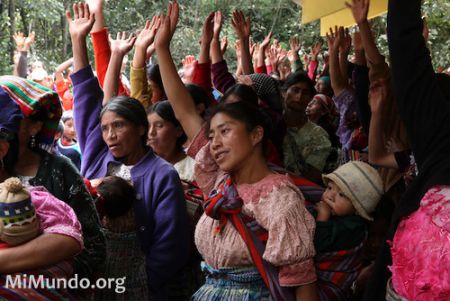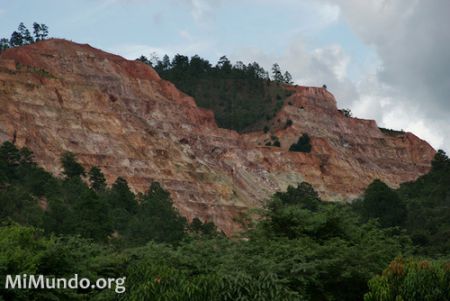STORY about EnvironmentHealthIndigenousSolidarity posted on September 7, 2013 by evlewis
Reclaiming Lands, Restoring Rights

Community consultation on the exploitation of natural resources in Santa Cruz del Quiché, Guatemala, 2010. (Photo by James A. Rodríguez / MiMundo.org)

Goldcorp's San Martin Gold Mine in the Siria Valley, Honduras, 2007. (Photo by James A. Rodríguez / MiMundo.org)
Also posted by evlewis:
Also in Solidarity:
Mining operations often have detrimental impacts on the health of the physical and human environments where they operate, yet the minerals produced are necessary for much of society to function and metal mining is not likely to disappear any time soon. While some of these detrimental impacts are inevitable, most negative social and environmental impacts are avoidable (Miranda, Chambers & Coumins, 2005). One of the ways to avoid some of the negative impacts of mining is for companies to consult with communities before beginning exploration and during the process of mine closure, as well as respect the right of Indigenous Peoples to free, prior and informed consent (FPIC). Another way would be for companies to ensure adequate security funds for mine closure and provide appropriate compensation to local communities.
Community Consultation and Free, Prior and Informed Consent
In a study by the World Bank called Voices of the Poor, it was found that impoverished and marginalized people described their well-being not in terms of their material needs, but in their ability to have their voices be heard (Okin, 2003). This finding registers with a survey by the International Council on Metals and Mining (ICMM) of mining-related human rights concerns, which found that nearly fifty percent of community complaints were around companies’ failure to conduct meaningful consultations or obtain community consent for projects (2013). In order for any agreements between mining companies and local communities to be reached, it is crucial that there be effective communication between both parties during all stages of mining operations, which includes public meetings and community consultations that are inclusive and culturally appropriate. This involves recognizing the community’s own representative institutions and engaging with the community in their native language (Miranda, Chambers & Coumins, 2005).
Some areas that have potential mining resources are too environmentally or socially sensitive and should be deemed “no go zones” (Miranda, Chambers & Coumins, 2005). These zones include UNESCO World Heritage Sites, yet there is the need for a broader criteria of “no go zones” that takes into account Indigenous peoples’ right to FPIC, which differs from community consultations. The former requires that host communities are informed of the potential impacts of mining and participate in decision-making processes, while the latter requires that companies hear the views of community members and take them into account in their decision-making (Laplante & Spears, 2008).
There are a number of international mechanisms in place to ensure Indigenous peoples’ right to FPIC. The UN Convention on Indigenous Peoples was adopted by the UN General Assembly in 2007. It was initially opposed by Canada, but has since been endorsed by all member states. Similarly, Article 7 of the ILO Convention 169 on Indigenous and Tribal Peoples states that “the peoples concerned shall have the right to decide their own priorities for the process of development as it affects their lives, beliefs, institutions and spiritual well-being and the lands they occupy or otherwise use, and to exercise control, to the extent possible, over their own economic, social and cultural development” (1989). These consent processes must be responsive and ongoing over the project’s lifetime. Despite these mechanisms, FPIC has largely not been adopted by mining companies, and local indigenous community members have often resorted to protests and other forms of resistance in order to have their voices heard.
It is also important that mining companies respect the decisions made by local Indigenous or non-Indigenous communities regarding mining exploration or exploitation in countries with a recent history of conflict and corrupt governance, as they often occur within a climate of impunity in favour of large-scale mining operations and the economy. Throughout Guatemala, there have been approximately seventy four local votes in communities surrounding mine sites since 2005 that have said no to mining operations (Gomez, 2013). However, these votes received little or no recognition by the Guatemalan government and saw no opportunities for negotiation with the mining companies. Rather, there has been an increase in militarization and repression against those opposed to mining since the proliferation of large-scale resource extraction projects in the country (Mining Watch, 2013).
Mine Closure and Reclamation
In most cases, metal mining requires the use of toxic chemicals, such as cyanide, arsenic, uranium, cadmium and lead, which can contaminate water sources and have long-term effects on the local population and environment (Laplante & Spears, 2008). One of the most common legacies associated with open pit mining is acid rock drainage, which is an invisible chemical reaction that can change the pH balance of the water and have detrimental impacts on local water sheds (Sandlos & Keeling, 2013).
In Canada, mining regulations require companies to submit mine closure plans (also referred to as reclamation plans) before receiving approval to commence mining activities (Cowan, Mackasey & Robertson, 2010). However, BC currently does not have any laws to ensure public participation in formulating mine closure plans (Stano, Lehrer & Grande, 2013). A survey by the National Orphaned/Abandoned Mines Initiative found that community involvement often leads to better decisions in regards to the reclamation of contaminated sites, as community members can provide local knowledge and information that may be lacking in professional processes (NOAMI 2003).
It is necessary that mine closure plans are supported by funds for mine decommissioning and reclamation, so that these costs do not become a public burden. For example, Barrick has been trying to get the Ontario provincial government to assume financial responsibility of their Renabie mine in the district of Sudbury since its closure in 1991 and has applied for an “exit ticket, which allows companies to walk away from future liability after paying a fee (Corp Watch Report, 2007). The company reported that reclamation work was complete in 1995, yet there are currently high levels of zinc, cobalt, iron and copper that flow from the surface water of the property, and in 1999, part of the underground mine collapsed, creating a large safety hazard for the local community (Corp Watch Report, 2007). Security funds align with the concept of the polluter pays principle and should be large enough to cover ongoing monitoring of the mine and any unexpected problems that may arise during that time. However, for many mining companies operating in communities abroad, there are inadequate security funds and no public tax money to pay for the cleanup. For example, at Goldcorp’s Marlin Mine in Guatemala, the estimated closure cost of the mine is $ 49 million, while Goldcorp’s current surety bond is only $1 million (US), leaving an impossible responsibility on the Guatemalan government (Mining Watch, 2012).
Equally important, is that mining companies provide adequate compensation to improve socioeconomic quality of life in communities in conjunction with local needs (Hilson 2002, 71). At Goldcorp’s former San Martin Mine in Honduras, where high levels of acid mine drainage have been identified, Goldcorp has failed to provide appropriate methods of reclamation or compensation for long-term water and soil contamination in the area surrounding the mine (Mining Watch, 2012). Instead, Goldcorp constructed an eco-tourism hotel and donated land, which they propose will provide “economic benefits and lasting self-sufficiency” (Goldcorp, 2013). However, the reality for local community members is that their environmental and health concerns are not being met, and fear that the eco-tourism site is a temporary placeholder for the mine to re-open in the future (Deutsch, 2013).
Recommendations
Below are some recommendations for Canadian mining companies and communities effected by mining:
- Ensure the development and implementation of procedures for informed community decision making. One possible method to ensure this happens is to include local and regional governments in coordinating mining land use policies, which may allow for the opportunity of targeting specific problems that are more in tune with the local communities affected (Hilson, 2002, 71).
- Adhere to human rights protocols, including indigenous peoples’ rights that are enshrined by the United Nations and other international organizations.
- Ensure environmental standards for operating mines, including closure plans and full funding for reclamation and clean up as a pre-condition for mining.
It is hoped that the improvement of Canadian mining standards and these recommendations can be applied to international operations by Canadian companies, which would likely increase the reputation and success of future mining projects.
References
Corp Watch. (2007, May). Barrick's dirty secrets: Communities worldwide respond to gold mining impacts. Retrieved from http://s3.amazonaws.com/corpwatch.org/downloads/Barrick_final_sml.pdf
Cowan, W. R., Mackasey, W. O., & Robertson, G. A. (2010, November). The policy framework in canada for mine closure and management of long-term liabilities: A guidance document. Retrieved from http://www.abandoned-mines.org/pdfs/PolicyFrameworkCanforMinClosureandMg...
Deutsch, R. (2013, June 18). Cyanide dreams: Ecotourism and mega-mining don’t mix in honduras. The Dominion, Retrieved from http://dominion.mediacoop.ca/story/cyanide-dreams/17716
Goldcorp Inc. (2013, July). Mine closure and reclamation case study: Eco-tourism & agricultural opportunities in honduras. Retrieved from http://www.miningwatch.ca/article/communities-shouldn-t-pay-clean-goldco...
Gomez, S. (2013, August 28). A new era for guatemala's indigenous peoples?. Retrieved from http://upsidedownworld.org/main/guatemala-archives-33/4429-a-new-era-for...
Hilson, G. (2002). An overview of land use conflicts in mining communities. Land Use Policy, 19, 65-73.
International Council on Mining and Metals (ICMM). (2013, May). Indigenous peoples and mining position statement. Retrieved from http://www.icmm.com/publications/icmm-position-statement-on-indigenous-p...
International Labour Organization (ILO). (1989). Indigenous and tribal peoples convention, 1989 (no. 169). Retrieved from website: http://www.ilo.org/dyn/normlex/en/f?p=1000:12100:0::NO::P12100_INSTRUMEN...
Laplante, L. J., & Speares, S. A. (2008). Out of the conflict zone: The case for community consent processes in the extractive sector. (Legal Studies Research Paper, Marquette University Law School).
Mining Watch Canada. (2012, June 15). Communities shouldn’t pay to clean up goldcorp’s mess in central america. Retrieved from http://www.miningwatch.ca/article/communities-shouldn-t-pay-clean-goldco...
Mining Watch Canada. (2013, September). Guatemalan indigenous organizations file complaint over mining law with inter-american commission on human rights. Retrieved from http://us4.campaign-archive2.com/?u=c89185f430617e4dc1a02762e&id=035b9cd...
Miranda, M., Chambers, D., & Coumans, C. (2005, October 19). Framework for responsible mining: A guide to evolving standards. Retrieved from http://www.frameworkforresponsiblemining.org/docs.html
National Orphaned/Abandoned Mines Initiative (NOAMI). (2003, February). Lessons learned on community involvement in the remediation of orphaned and abandoned mines. Retrieved from http://www.abandoned-mines.org/pdfs/LessonsLearned.pdf
Okin, S. M. (2003). Poverty, well-being and gender: What counts, who's heard?. Philosophy and Public Affairs, 31(3), 280-316. Retrieved from http://www.artsrn.ualberta.ca/courses/PoliticalScience/474A1/documents/S...
Rodríguez , J. A. (Photographer). (2010, October 22). 2010: Consultation in Santa Cruz Quiché [Web Photo]. Retrieved from http://mimundo.photoshelter.com/gallery-image/2010-Consultation-in-Santa...
Rodríguez , J. A. (Photographer). (2007, August 18). Goldcorp in Siria Valley [Web Photo]. Retrieved from http://mimundo.photoshelter.com/gallery-image/Mining-Goldcorp-in-Siria-V...
Sandlos, J., & Keeling, A. (2013). zombie mines and the (over)burden of history . The Solutions Journal, 4(3), 80-83. Retrieved from http://thesolutionsjournal.com/node/23361
Stano, M., Lehrer, E., & Grande, G. (2013, March). Community preparation background paper negotiation of agreements. Retrieved from http://fairmining.ca/wp-content/uploads/2013/07/Chapter-1-Negotiation-of...
The site for the Vancouver local of The Media Co-op has been archived and will no longer be updated. Please visit the main Media Co-op website to learn more about the organization.